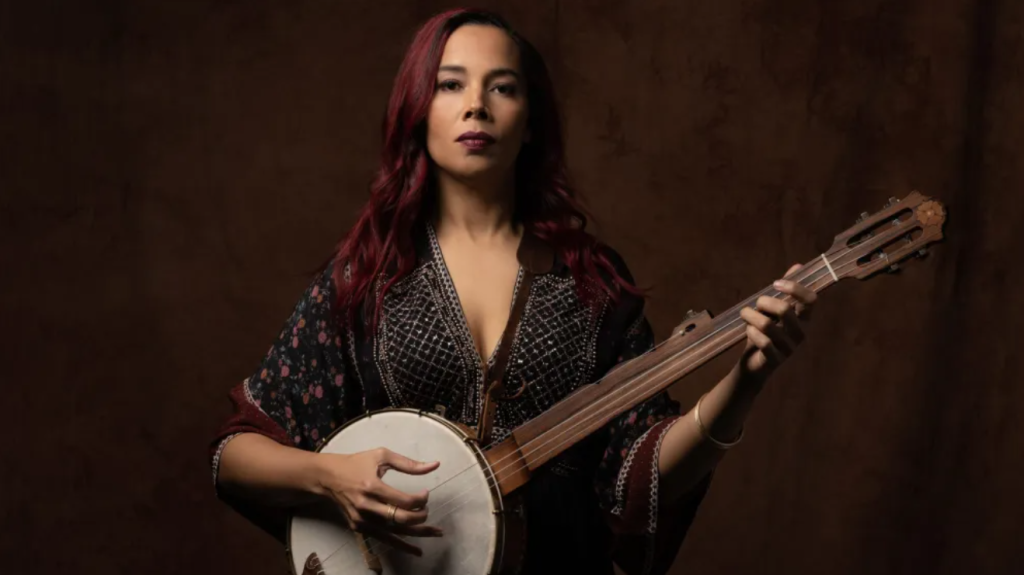She’s reclaiming a piece of Black history!
By now, you’ve heard the stirring twang of the banjo at the beginning of Beyoncé’s newly released country single, “Texas Hold’em,” but you may not have heard of the sister behind the strings. Rhiannon Giddens is the lead singer, fiddle player, and banjo player behind the Grammy Award-winning bluegrass group, “The Carolina Chocolate Drops.” She’s played the banjo for over two decades and is leading the way in making sure the nation knows the Black history of this instrument–and its significance in Southern culture.
“The banjo is an African invention, it has African ancestry and it was invented by the African ancestors in the Caribbean,” Giddens said in an interview for Wondrium. “It’s important to our correct understanding of where American culture comes from.”
Enslaved African Americans invented the instrument that would come to be known as the banjo long before its sound was associated with barefooted old white men in overalls pickin’ and grinnin’ on the front porch. It has its roots in the Caribbean, a frequent stop during the Transatlantic slave trade, where enslaved Africans invented of the gourd banjo made from a gourd head with four strings stretched across, reminiscent of similar string instruments played across the African continent.
“I didn’t grow up knowing any of this history,” Giddens said. “All of this changed when I became an adult.”
Giddens was born and raised in Greensboro, North Carolina, and attended contradances––a form of folk dancing where couples dance in two long lines––where she first heard a rhythmic, funky, danceable version of the instrument she’d long associated with whiteness.
“I’ve never heard the banjo sound like this. I could feel it in my soul in a different way than bluegrass music. I became hooked to the sound of the clawhammer banjo. I realized that I wanted to play it, it wasn’t enough to dance to it,” Giddens said.
So Giddens bought a banjo and a fiddle, and her career as a bluegrass musician was born.
“I was the raisin in the oatmeal, I was the only person of color in the room,” she recalls of attending bluegrass venues on her own. “Ninety-nine percent of the time it was just me. I felt like I had to ask permission to be in this music. There’s this idea that this music is kind of a preserve of a certain area.” But these awkward moments led Giddens to try to understand how the instrument came to be associated with Southern white culture.
While attending the first Black Banjo Gathering in Boone, North Carolina, Giddens met a musician from The Gambia playing the akonting, an instrument originating in Senegal that has sonic and visual similarities to the old-time banjo we’re familiar with today.
“The banjo isn’t necessarily from Africa, it wasn’t invented in Africa, but [the idea of it] starts even before Africa because you have instruments that start in the far East, they move into the Middle East, they go down into Africa and they go up into Europe. They change wherever they go and they’re being changed by the people,” Giddens said.
In his book “The Banjo: An African American Instrument,” Laurent Dubois explains that the banjo was used to “connect with ancestors and gods. Its role was not just sonic, but also spiritual.” Enslavers themselves would also use this instrument to ensure healthier cargo by bringing enslaved Africans from the bowels of the ship and forcing them to play and dance to the string music.
As time progressed, so did the banjo. The banjo evolved in design and came to be used in minstrel shows and jazz performances in the early 20th century. Its distinct sound grew in popularity among a variety of performers, including bluegrass, old-time, and country musicians of all races.
Through Giddens’ work educating the masses about the banjo’s little-known Black history and through music from her bluegrass band (and from Queen Bey herself), we’re getting closer to reconnecting this instrument to the culture that birthed its shape and sound.
“It goes all the way back to Africa in terms of people, in terms of memories, in terms of what came first and the culture that this music and the need to survive came out of,” Giddens said.
Cover photo: Rhiannon Giddens Leads Nation in Revealing the Black Roots of the Banjo/ Rhiannon Giddens/ Photo credit: rhiannongiddens.com

